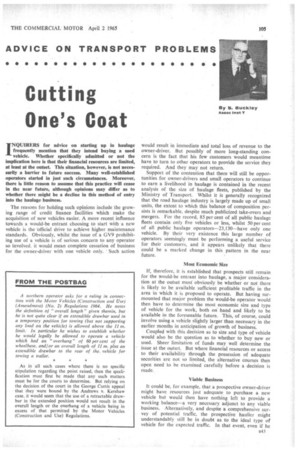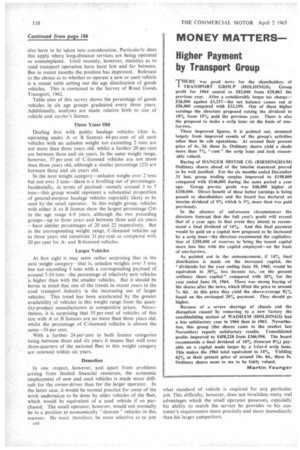Cutting One's Coat
Page 107

Page 108

Page 112

If you've noticed an error in this article please click here to report it so we can fix it.
INQU1RERS for advice on starting up in haulage frequently mention that they intend buying a used vehicle. Whether specifically admitted or not the implication here is that their financial resources are limited, at least at the outset. This situation, however, is not necessarily a barrier to future success. Many well-established operators started in just such circumstances. Moreover, there is little reason to assume that this practice will cease in the near future, although opinions may differ as to whether there might be a decline in this method of entry into the haulage business.
The reasons for holding such opinions include the growing range of credit finance facilities which make the acquisition of new vehicles easier. A more recent influence towards a would-be entrant choosing to start with a new vehicle is the 'official drive to achieve higher maintenance standards. Obviously, whilst the issue of a GV9 prohibiting use of a vehicle is of serious concern to any operator so involved, it would mean complete cessation of business for the owner-driver with one vehicle only. ' Such action would result in immediate and total loss of revenue to the owner-driver. But possibly of more long-standing concern is the fact that his few customers would meantime have to turn to other operators to provide the service they required. And they may not return.
Support of the contention that there will still be opportunities for owner-drivers and small operators to continue to earn a livelihood in haulage is contained in the recent analysis of the size of haulage fleets, published by the Ministry of Transport. Whilst it is generally recognized that the road haulage industry is largely made up of small units, the extent to which this balance of composition persists is remarkable, despite much publicized take-overs and mergers. For the record, 85 per cent of all public haulage fleets contain only five vehicles or less, whilst 50 per cent of all public haulage operators-23,I30—have only one vehicle. By their very existence this large number of operators seemingly must be performing a useful service for their customers, and it appears unlikely that there could be a marked change in this pattern in the near future.
Most Economic Size If, therefore, it is established that prospects still remain for the would-be entrant into haulage, a major consideration at the outset must obviously be whether or not there is likely to be available sufficient profitable traffic in the area in which it is proposed to operate. But having surmounted that major problem the would-be operator would then have to determine the most economic size and type of vehicle for the work, both on hand and likely to be available in the foreseeable future. This, of course, could involve using a vehicle slightly larger than necessary in the earlier months in anticipation of growth of business.
Coupled with this decision as to size and type of vehicle would also be the question as to whether to buy new or used. Sheer limitation of funds may well determine the issue at the outset. But where financial resources or access to their availability through the possession of adequate securities are not so limited, the alternative courses then open need to be examined carefully before a decision is made.
Viable Business It could be, for example, that a prospective owner-driver might have resources just adequate_ to purchase a new vehicle but would then have nothing left to provide a working balance—a very necessary adjunct to any viable business. Alternatively, and despite a comprehensive survey of potential traffic, the prospective haulier might understandably still be in doubt as to the ideal type of vehicle for the expected traffic. In that event, even if he had adequate resources to buy new, he might feel disposed to experiment with a lower-priced used vehicle until, in practice, he had established just what was the best type of vehicle for the job.
New or Used?
Whether or not this latter decision, as between a new or used vehicle, is made initially or during the early stages of operation, it is important to get the relevant facts correct and in perspective. In all such decisions obviously it is essential not only to ensure that any comparisons are valid, but also that they are relevant. As in many other problems Concerning road transport operation, the fact that transport is a service can tend to confuse the issue, at least superficially. Ideally, it might be contended that there is only one standard of transport service—namely, the movement of goods or passengers from A to B to the satisfaction of the customer concerned. But in more practical terms every operator and many customers appreciate that this is an ultraistic attitude. The very existence of a large and continuing used commercial vehicle market and, moreover, grades of vehicles from new to old in practically every large fleet, establishes the case for "horses for courses ".
Existing Examples Accordingly, when a would-be operator is considering the several advantages and disadvantages of alternative policies of operating with either new or used vehicles, the existing examples of established operators in the locality should not be accepted too readily. Thus the possession of a well-established maintenance depot might resolve problems of ageing vehicles for the large operator but not for the owner-driver without such facilities. On the traffic side the relative urgency of his traffic compared with that of competitors might also have some bearing on whether used or new vehicles would be justified. On the engineering side• it could be contended that the economics of maintenance make it impossible for the onevehicle operator to be competitive—on this score at least —with, say, the 30-vehicle fleets which possibly could justify a double-shift maintenance system. But the fact remains that many owner-drivers have made a success of their ventures. In their early days it was largely achieved by a hidden subsidy—namely, their readiness to apply their engineering skill in the evenings and at week-ends to keep their vehicles on the road. In practice, in their determination to be their own masters, they were prepared to do two jobs for one pay packet until they were firmly established. But once the business grows and men are employed specifically for maintenance, then obviously a different set of circumstances arises, with "both allied advantages and disadvantages.
Differing Standards If a would-be operator has convinced himself that for a specific job and limited period a used vehicle would seem advisable, then it is important that he should know in advance the likely variations in operating costs as compared with a new vehicle. As stated earlier, there can be differences in the standard of service both required and provided. Accordingly, differing standards of vehicles to perform that service may also be needed if the job is to be done economically. In this context it should not be overlooked that an unnecessarily high standard could be a luxury and a contradiction of the term "commercial vehicle ".
Because road transport is a highly competitive industry, it is essential for a haulier to consider the standard of service provided by other local hauliers, as well as the level of rates, before entering into any new projects. Whilst such a comparisonon a local basis would be little more than a matter of personal observation, national standards continued on page 110 also have to be taken into consideration. Particularly does this apply where long-distance services are being operated or contemplated. Until recently, however, statistics as to road transport operation have been few and far between. But in recent months the position has improved. Relevant to the choice as to whether to operate a new or used vehicle is a recent table setting out the age distribution of goods vehicles. This is contained in the Survey of Road Goods Transport, 1962.
Table nine of this survey shows the percentage of goods vehicles in six age groups graduated every three years. Additionally, analyses are made relative both to size of vehicle and carrier's licence.
Three Years Old Dealing first with public haulage vehicles (that is, operating under A or B licence) 44 per cent of all such vehicles with an unladen weight not exceeding 2 tons are not more than three years old, whilst a further 20 per cent are between three and six years. In the same weight range, however, 57 per cent of C-licensed vehicles are not more than three years old, although a similar percentage (23) are between three and six years old.
In the next weight category—unladen weight over 2 tons but not over 3 tons—there is a levelling out of percentages. Incidentally, in terms of payload-=namely around 3 to 7 tons—this group would represent a substantial proportion of general-purpose haulage vehicles especially likely to be used by the small operator. In this weight group, vehicles with either A or B licence show the largest percentage (24) in the age range 6-9 years, although the two preceding groups—up to three years and between three and six years —have similar percentages of 20 and 22 respectively. But in the corresponding weight range, C-licensed vehicles up to three years old constitute 31 per cent as compared with 20 per cent for Aand B-licensed vehicles.
Larger Vehicles At first sight it may seem rather surprising that in the next weight category—that is, unladen weights over 3 tons but not exceeding 5 tons with a corresponding payload of around 7-10 tons—the percentage of relatively new vehicles is higher than with the smaller vehicles. But it should be borne in mind that one of the trends in recent years in the road transport industry is the increasing use of larger vehicles. • This trend has been accelerated by the greater availability of vehicles in this weight range from the quantity-product manufacturers at competitive prices. Nevertheless, it is surprising that 55 per cent of vehicles of this size with A or B licences are no more than three years old, whilst the percentage of C-licensed vehicles is almost the same-54 per cent.
With a further 24 per cent in both licence categories being between three and six years it means that well over three-quarters of the national fleet in this weight category are renewed within six years.
Demotion In one respect, however, and apart from problems arising from limited financial resources, the economic employment of new and used vehicles is made more difficult for the owner-driver than for the larger operator. In the latter case, it -would be normal practice for some of the work undertaken to be done by older vehicles of the fleet, which would be equivalent of a used vehicle if so purchased. The small operator, however, would not normally be in a position to economically demote vehicles in this manner. He must, therefore, be more selective as to just a4s what standard of vehicle is required for any particular job. This difficulty, however, does not invalidate many real advantages which the small operator possesses, especially his ability to match the service he provides to his customer's requirements more precisely and more immediately than his larger competitors.


































































































































































